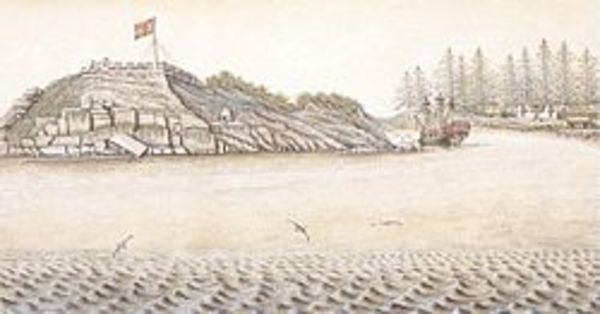
Source: Courtesy of Wikimedia Commons
ALBERNI, PEDRO DE, army officer; b. 1747 in Tortosa, Spain; d. 11 March 1802 in Monterey (Calif.).
Pedro de Alberni joined the Volunteer Regiment of Catalonia as a cadet in 1762 and saw some active service against Portugal. In 1768 his company was detached from the regiment and transferred to New Spain as the 1st Free Company of Volunteers of Catalonia. There Alberni participated in numerous engagements against the Indians of the northern frontier (the Mexican-American border country), and, recognized as an intelligent and valuable officer, he was promoted captain and commanding officer of his company on 24 March 1783. At some time before 1789 Alberni was for seven years military commander of the province of Nayarit.
Following the temporary occupation of Nootka Sound (B.C.) in 1789 by Esteban José Martinez*, Viceroy Revilla Gigedo of New Spain decided to establish a more permanent presence there with a fortified post capable of defence against the British, Russians, or Americans [see James Colnett; Joseph Billings; Robert Gray]. The viceroy assigned naval lieutenant Francisco de Eliza* y Reventa to command the expedition of three ships, and Alberni with his company was to fortify and garrison the post. Alberni received orders to prepare for northern duty in September 1789, while stationed at Guadalajara (Mexico). He was short about 15 men, and described another 23 as unfit for the rigours of northern service. Wishing to have the greatest possible number of Europeans at Nootka, the authorities of New Spain allowed him to recruit among Catalonians originally sent from Spain to serve elsewhere in the empire. Alberni requested new arms to replace warn-out equipment and demanded clothing suited to the northern climate. The consequent delays led Revilla Gigedo to charge him with insubordination and with hindering movement to San Blas (state of Nayarit), the port of embarkation. On 3 Feb. 1790 Alberni sailed with charges still pending and was held in confinement for the duration of the voyage north. These circumstances may explain his long posting to Nootka and the special efforts made by his fellow officers to commend his zeal to the viceroy.
When Eliza’s expedition landed at Friendly Cove on 5 April, Alberni and his 76 soldiers began to fortify the harbour. Although their instructions called for them to mount 20 cannon, only 14 were placed. Hard labour, a poor diet, and the wet climate weakened the soldiers, who suffered from scurvy, dysentery, and colds. Alberni sent many to California missions to recuperate; by August 1790 only 31 soldiers remained.
Despite the hardships, Alberni threw himself into preparations for the coming winter. Contemporaries praised his vigour in erecting buildings with boards obtained from the Indians and in excavating wells and operating an efficient bakery. He also undertook to raise poultry and, aware of the importance of fresh vegetables, made himself one of the first gardeners on the northwest coast. In spite of Alberni’s prophylactic efforts five soldiers perished during the winter, and in March 1791, 32 seamen and soldiers were dispatched to California because of illness. Throughout this period Eliza found Alberni to be a major source of strength to the garrison, maintaining military discipline and promoting harmony between officers and men by his good example.
In 1791 Alberni expanded his horticultural efforts and was able to place the settlement on a better footing for the next winter. He was instrumental in improving relations with the local Nootkas, who were distressed by a number of confrontations with the enlisted men, and by the Spaniards’ occupation of the site of Yuquot, their summer village. When he learned that the Indians used flattery and songs in their own diplomacy, Alberni successfully emulated them with a simple verse for the soldiers to sing in Nootkan, praising chief Muquinna* and set to a popular Spanish melody. Alberni is credited with a large contribution to the compilation of a Nootkan-Spanish vocabulary, but he did not write any major account of the Spanish presence in Nootka Sound. Even so, he was there long enough to become an important source of information for others. Among the Spanish explorers on the northwest coast, naval officers Alejandro Malaspina and Juan Francisco de la Bodega* y Quadra, and naturalist José Mariano Moziño praised his ability and intelligence. Supported by fellow officers’ reports of his conduct, Alberni was successful in having the charge of insubordination dropped.
Bodega having arrived on 29 April 1792 to assume command at Nootka Sound, Alberni left there on 1 July; after a delay in Monterey he reached San Blas late in November. On 1 July he had been promoted lieutenant-colonel, and some time after his return he served for eight months as commander of the great castle of San Juan de Ulúa at Veracruz (Mexico) and king’s lieutenant of the port. When in 1796 the colonial régime once again feared foreign encroachment on the thinly settled California coast, Alberni with his company was sent to garrison San Francisco. Probably at the same time he was named military commander of the four major California presidios. Later transferred to Monterey, he died there on 11 March 1802.
Archivo General de Indias (Seville, Spain), Audiencia de México, legajo 1515, legajo 2424. Archivo General de la Nación (Mexico City), Sección de Historia, vol.69. Archivo General de Simancas (Simancas, Spain), Sección de Guerra y Marina, Guerra Moderna, legajo 7277. Museo Naval (Madrid), ms nos.271, 330–31. Provincial Arch. of B.C. (Victoria), “Original manuscript letters of Pedro Alberni, Commander Quadra, Gigedo and other Spanish officials concerning Spanish occupation on the northwest coast of America, 1789–93” (photocopies). J. M. Moziño [Losada] Suárez de Figueroa, Noticias de Nutka: an account of Nootka Sound in 1792, trans. and ed. I. H. Wilson [Engstrand] (Seattle, Wash., 1970). Viaje politico-científico alrededor del mundo por las corbetas Descubierta y Atrevida al mando de los capitanes de navío D. Alejandro Malaspina y Don José de Bustamante y Guerra desde 1789 á 1794, ed. Pedro de Novo y Colson (Madrid, 1885). F. X. de Viana, Diario del viaje explorador de las corbetas españolas “Descubierta” y “Atrevida” en los años de 1789 á 1794 . . . (Cerrito de la Victoria, Uruguay, 1849); repub. as Diario de viaje (2v., Montevideo, 1958). Cook, Flood tide of empire. C. I. Archer, “The transient presence: a re-appraisal of Spanish attitudes toward the northwest coast in the eighteenth century,” BC Studies (Vancouver), no.18 (summer 1973): 3–32.
Cite This Article
Christon I. Archer, “ALBERNI, PEDRO DE,” in Dictionary of Canadian Biography, vol. 5, University of Toronto/Université Laval, 2003–, accessed January 7, 2026, https://www.biographi.ca/en/bio/alberni_pedro_de_5E.html.
The citation above shows the format for footnotes and endnotes according to the Chicago manual of style (16th edition). Information to be used in other citation formats:
| Permalink: | https://www.biographi.ca/en/bio/alberni_pedro_de_5E.html |
| Author of Article: | Christon I. Archer |
| Title of Article: | ALBERNI, PEDRO DE |
| Publication Name: | Dictionary of Canadian Biography, vol. 5 |
| Publisher: | University of Toronto/Université Laval |
| Year of publication: | 1983 |
| Year of revision: | 1983 |
| Access Date: | January 7, 2026 |



